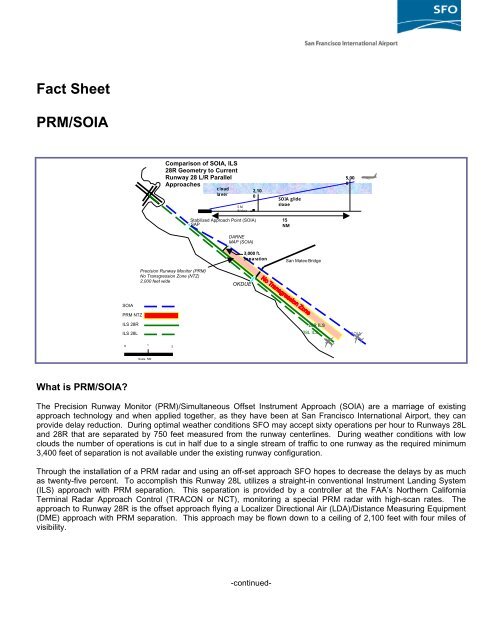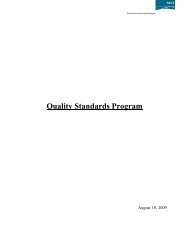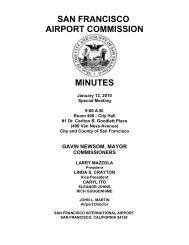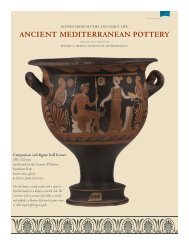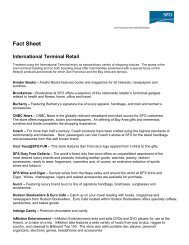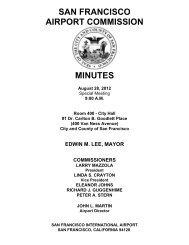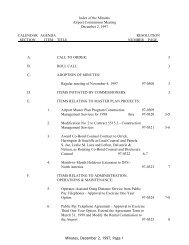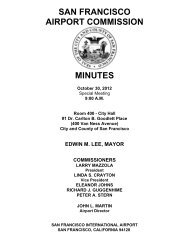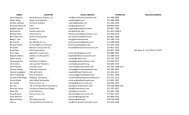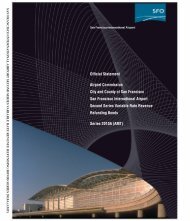PRM/SOIA - San Francisco International Airport
PRM/SOIA - San Francisco International Airport
PRM/SOIA - San Francisco International Airport
- No tags were found...
You also want an ePaper? Increase the reach of your titles
YUMPU automatically turns print PDFs into web optimized ePapers that Google loves.
Fact Sheet<strong>PRM</strong>/<strong>SOIA</strong>Comparison of <strong>SOIA</strong>, ILS28R Geometry to CurrentRunway 28 L/R ParallelApproachescloudlayerS MBridgeStabilized Approach Point (<strong>SOIA</strong>)SAPDARNEMAP (<strong>SOIA</strong>)2,1003,000 ft.separation<strong>SOIA</strong> glideslope15NM<strong>San</strong> Mateo Bridge5,000Precision Runway Monitor (<strong>PRM</strong>)No Transgression Zone (NTZ)2,000 feet wideOKDUE<strong>SOIA</strong><strong>PRM</strong> NTZILS 28RILS 28L28R ILS28L ILS<strong>SOIA</strong>O 12Scale NMWhat is <strong>PRM</strong>/<strong>SOIA</strong>?The Precision Runway Monitor (<strong>PRM</strong>)/Simultaneous Offset Instrument Approach (<strong>SOIA</strong>) are a marriage of existingapproach technology and when applied together, as they have been at <strong>San</strong> <strong>Francisco</strong> <strong>International</strong> <strong>Airport</strong>, they canprovide delay reduction. During optimal weather conditions SFO may accept sixty operations per hour to Runways 28Land 28R that are separated by 750 feet measured from the runway centerlines. During weather conditions with lowclouds the number of operations is cut in half due to a single stream of traffic to one runway as the required minimum3,400 feet of separation is not available under the existing runway configuration.Through the installation of a <strong>PRM</strong> radar and using an off-set approach SFO hopes to decrease the delays by as muchas twenty-five percent. To accomplish this Runway 28L utilizes a straight-in conventional Instrument Landing System(ILS) approach with <strong>PRM</strong> separation. This separation is provided by a controller at the FAA’s Northern CaliforniaTerminal Radar Approach Control (TRACON or NCT), monitoring a special <strong>PRM</strong> radar with high-scan rates. Theapproach to Runway 28R is the offset approach flying a Localizer Directional Air (LDA)/Distance Measuring Equipment(DME) approach with <strong>PRM</strong> separation. This approach may be flown down to a ceiling of 2,100 feet with four miles ofvisibility.-continued-
GlossaryDMEILSLDAMissed ApproachNTZ<strong>SOIA</strong><strong>PRM</strong>Distance Measuring Equipment – Equipment (airborne and ground) used to measure, innautical miles, a slant range distance of an aircraft from the DME navigational aid. It isoften used to define the point where an aircraft turns.An Instrument Landing System is a precision instrument approach system whichnormally consists of a localizer for horizontal guidance, a guide slope for vertical guidance,marker beacons, and approach lights.Localizer Type Directional Aid – An approach of comparable utility and accuracy to alocalizer, but not part of a complete ILS and not aligned with the runway.Sometimes called a “go around”; this is a maneuver where a pilot cannot execute alanding due to weather or inadequate separation of aircraft. The pilot then climbs theaircraft and circles on a pre-determined path before approaching the runway again.No Transgression Zone is a protected are between the approaches and is monitored bythe <strong>PRM</strong> controller. Aircraft straying into the NTZ should expect to be sent missedapproach. The SFO NTZ is 3,000 feet wide and approximately eleven miles long.Simultaneous Offset Instrument Approach is an approach system permittingsimultaneous Instrument Landing System approaches to airports having staggered butparallel runways. <strong>SOIA</strong> combines Offset ILS and regular ILS definitions.Precision Runway Monitor – A system of high-resolution monitors for air trafficcontrollers to use in landing aircraft on parallel runways separated by less than 4,300’.10/04


